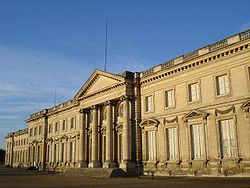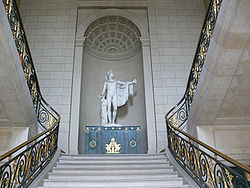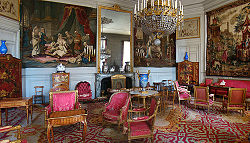
Château de Compiègne
Encyclopedia



France
The French Republic , The French Republic , The French Republic , (commonly known as France , is a unitary semi-presidential republic in Western Europe with several overseas territories and islands located on other continents and in the Indian, Pacific, and Atlantic oceans. Metropolitan France...
château
Château
A château is a manor house or residence of the lord of the manor or a country house of nobility or gentry, with or without fortifications, originally—and still most frequently—in French-speaking regions...
, a royal residence built for Louis XV
Louis XV of France
Louis XV was a Bourbon monarch who ruled as King of France and of Navarre from 1 September 1715 until his death. He succeeded his great-grandfather at the age of five, his first cousin Philippe II, Duke of Orléans, served as Regent of the kingdom until Louis's majority in 1723...
and restored by Napoleon
Napoleon I of France
Napoleon Bonaparte was a French military and political leader during the latter stages of the French Revolution.As Napoleon I, he was Emperor of the French from 1804 to 1815...
. Compiègne was one of three seats of royal government, the others being Versailles
Palace of Versailles
The Palace of Versailles , or simply Versailles, is a royal château in Versailles in the Île-de-France region of France. In French it is the Château de Versailles....
and Fontainebleau
Château de Fontainebleau
The Palace of Fontainebleau, located 55 kilometres from the centre of Paris, is one of the largest French royal châteaux. The palace as it is today is the work of many French monarchs, building on an early 16th century structure of Francis I. The building is arranged around a series of courtyards...
. It is located in Compiègne
Compiègne
Compiègne is a city in northern France. It is designated municipally as a commune within the département of Oise.The city is located along the Oise River...
in the Oise
Oise
Oise is a department in the north of France. It is named after the river Oise.-History:Oise is one of the original 83 departments created during the French Revolution on March 4, 1790...
département, and open to the public.
Even before the château was constructed, Compiègne was the preferred summer residence for French monarchs, primarily for hunting given its proximity to Compiègne Forest. The first royal residence was built in 1374 for Charles V
Charles V of France
Charles V , called the Wise, was King of France from 1364 to his death in 1380 and a member of the House of Valois...
and a long procession of successors both visited it and modified it. Louis XIV resided in Compiègne some 75 times. Louis XV was perhaps even more favorably impressed; the Comte de Chevergny described his infatuation: "Hunting was his main passion... and Compiègne, with its immense forest, with its endless avenues amongst the trees, with its stretches down which you could ride all day and never come to the end, was the ideal place to indulge that passion."
In 1750, prominent architect Ange-Jacques Gabriel
Ange-Jacques Gabriel
Ange-Jacques Gabriel was the most prominent French architect of his generation.Born to a Parisian family of architects and initially trained by the royal architect Robert de Cotte and his father , whom he assisted in the creation of the Place Royale at Bordeaux , the younger Gabriel...
proposed a thorough renovation of the château. Work began in 1751 and was finished in 1788 by Gabriel's student Le Dreux de La Châtre. The ancient town ramparts dictated the château's triangular plan; the resultant building covers about 5 acres (20,234.3 m²). It is Neoclassical in style, with simplicity and clarity governing both its external and interior features.
During the French Revolution
French Revolution
The French Revolution , sometimes distinguished as the 'Great French Revolution' , was a period of radical social and political upheaval in France and Europe. The absolute monarchy that had ruled France for centuries collapsed in three years...
, the château passed into the jurisdiction of the Minister for the Interior. In 1795 all furniture was sold and its works of art were sent to the Muséum Central; it was essentially gutted.
Napoleon visited in 1799 and again in 1803. In 1804 the château became an imperial domain and in 1807 he ordered it be made habitable again. Architects Berthault, Percier
Charles Percier
Charles Percier was a neoclassical French architect, interior decorator and designer, who worked in a close partnership with Pierre François Léonard Fontaine, originally his friend from student days...
and Fontaine
Pierre François Léonard Fontaine
Pierre François Léonard Fontaine was a neoclassical French architect, interior decorator and designer.Starting from 1794 Fontaine worked in such close partnership with Charles Percier, originally his friend from student days, that it is difficult to distinguish their work...
, decorators Dubois and Redouté
Pierre-Joseph Redouté
Pierre-Joseph Redouté , was a Belgian painter and botanist, known for his watercolours of roses, lilies and other flowers at Malmaison. He was nicknamed "The Raphael of flowers"....
, and cabinetmakers Jacob-Desmalter
François-Honoré-Georges Jacob-Desmalter
François-Honoré-Georges Jacob-Desmalter oversaw one of the most successful and influential furniture workshops in Paris, from 1796 to 1825...
and Marcion restored the château. Its layout was altered, a ballroom added, and the garden was replanted and linked directly to the forest.
The result is an example of First French Empire
First French Empire
The First French Empire , also known as the Greater French Empire or Napoleonic Empire, was the empire of Napoleon I of France...
style (1808-1810), though some traces of the earlier décor survive. Auguste Luchet remarked that "Compiègne speaks of Napoleon as Versailles does of Louis XIV". From 1856 on, Napoleon III
Napoleon III of France
Louis-Napoléon Bonaparte was the President of the French Second Republic and as Napoleon III, the ruler of the Second French Empire. He was the nephew and heir of Napoleon I, christened as Charles Louis Napoléon Bonaparte...
and Eugénie made it their autumn residence, and redecorated some rooms in the Second Empire style.
Today's visitors can find three distinct museums within the chateau: the apartments themselves; the Museum of the Second Empire; and the National Car Museum (Le Musée de la Voiture), founded in 1927, with a collection of carriage
Carriage
A carriage is a wheeled vehicle for people, usually horse-drawn; litters and sedan chairs are excluded, since they are wheelless vehicles. The carriage is especially designed for private passenger use and for comfort or elegance, though some are also used to transport goods. It may be light,...
s, bicycle
Bicycle
A bicycle, also known as a bike, pushbike or cycle, is a human-powered, pedal-driven, single-track vehicle, having two wheels attached to a frame, one behind the other. A person who rides a bicycle is called a cyclist, or bicyclist....
s, and automobile
Automobile
An automobile, autocar, motor car or car is a wheeled motor vehicle used for transporting passengers, which also carries its own engine or motor...
s.

